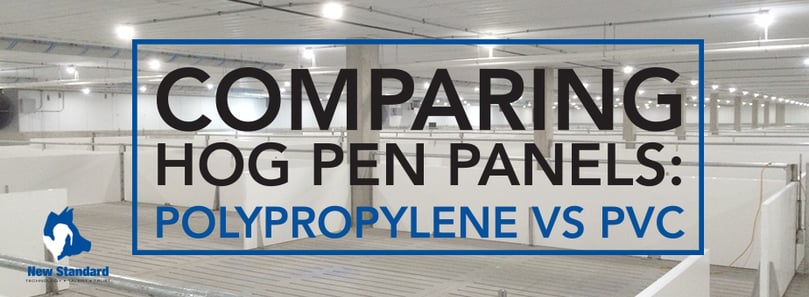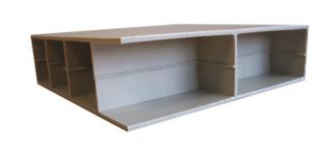
Installing new hog penning and gating systems into your existing or new swine barn has a large impact on the quality and efficiency of the barn. When deciding what products to install, you have to make tough decisions on the strength and lifespan of the panels, as well as the health risk each presents to your animals. After working with both PVC and polypropylene products, we strongly recommend Paneltim polypropylene hog pen panels. Read more on how these panels compare to traditional PVC panels when it comes to hygiene and biosecurity, product strength, and environmental friendliness.
Hygiene and Biosecurity
Internal Cell Structure
Traditional PVC hog pen panels consist of internal tubes that run through the entire panel. Having these open tubes allows dirt, water, and other substances to more easily enter the panel. These substances can stay trapped inside the panel if not cleaned with extreme care, increasing the risk of breaches in biosecurity.
Paneltim's polypropylene panels, on the other hand, are made up of square sealed cells and have an internal cell structure of 2”/4”. This ensures that all sides of the panels are always closed, even with customized, made-to-measure, panels. This cell structure will not allow harmful substances to leak into and stay trapped in the panel.

Cleaning Panel Surfaces
Polypropylene hog pen panels are non-porous making them easy to clean with high pressure water. They will not trap manure or any other substances in the surface. This allows you to clean and remove stains as well as remove any viruses and bacteria so they don't hang around and infect your animals.
PVC paneling has come a long way in this aspect, but American PVC's properties are not quite as advanced yet. The molecular structure of PVC paneling is not as tight. This is more noticeable over time as the panels have had more contact with manure. Over time, the panel surfaces break down and become contaminated as substances lock in and are not able to be removed.
For more insight on the hygiene and biosecurity of Paneltim products vs traditional PVC products, view the images in the following document:
Panel Strength
Because PVC penning is fairly brittle, it typically shatters upon contact more easily than polypropylene. When comparing the Izod Impact Strength of each product, you will find that polypropylene panels hold up to impact much better. If needed in boar pens or other places where you need stronger panels, Paneltim even offers panels with a 2”/2” cellular structure, which are almost unbreakable.
We have found that polypropylene is a wise investment. You will likely save money on the paneling alone if you use PVC products, but the strength of your materials has a large impact on the number of fittings you need. In the end, you will spend more on fittings and installation labor when putting PVC hog pen panels in your barn. Plus, the polypropylene panels will last much longer since they are noncorrosive and won't be affected by your animals dung and urine.
Environmental Friendliness
With major consumer concerns on environmental issues, it is essential that the pork industry pays attention to and implements more environmentally friendly solutions in swine barns. Polypropylene is one of the most neutral plastics, being made up of only carbon and hydrogen, while PVC is about 30% by weight Chlorine. It is widely know that Chlorine is dangerous to the environment. Although there’s been major progress in Europe, in the USA there’s still widespread use of lead-based stabilizers in the creation of PVC. This lead can be highly toxic both in the product's life cycle and after it is thrown away. When PVC panels are disposed of or caught in an accidental fire, they produce toxic byproducts. Again, PVC panels do not last as long as polypropylene, so they will be disposed of more often, adding more harmful waste to the environment.
Polypropylene is also produced from a gas called propylene monomer, which is a byproduct of the petroleum industry. Before producing this material, it was burned off into the atmosphere, adding to already existent environmental issues. Producing polypropylene recycles potential greenhouse gases and creates a strong, long-lasting product. Also unlike PVC, when polypropylene hog pen panels finally reach the end of their life cycle, they are 100% recyclable.
If you are interested in learning more about Paneltim hog pen paneling, we would love to have a conversation with you. Give us a call today or click the button below to set up a meeting.





